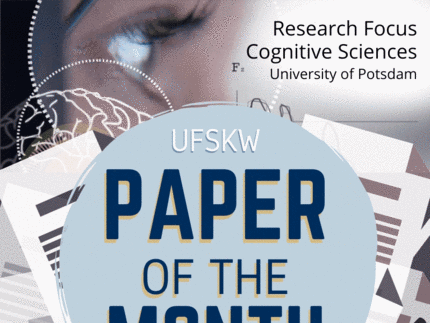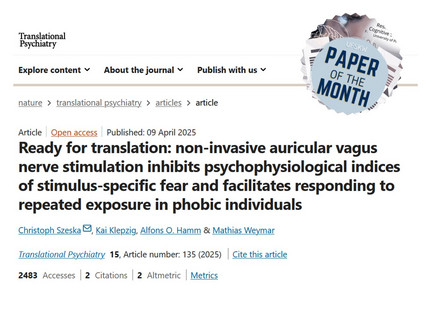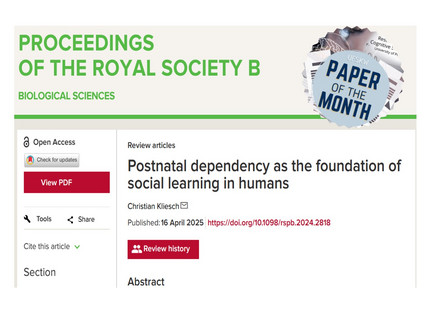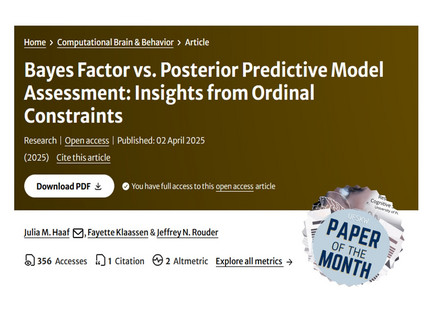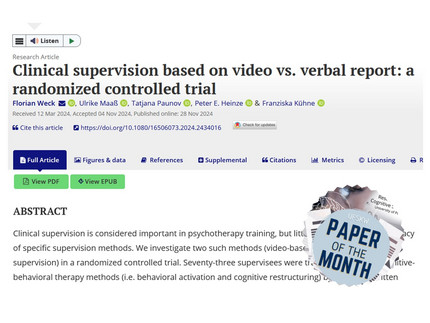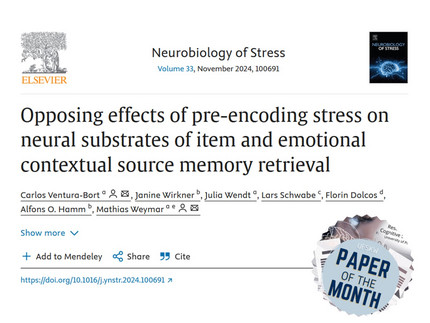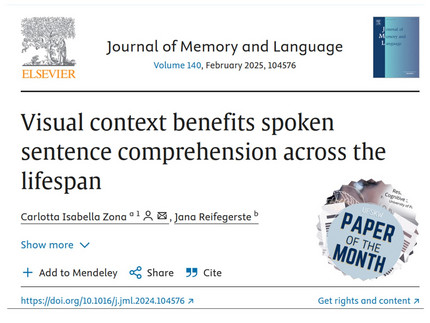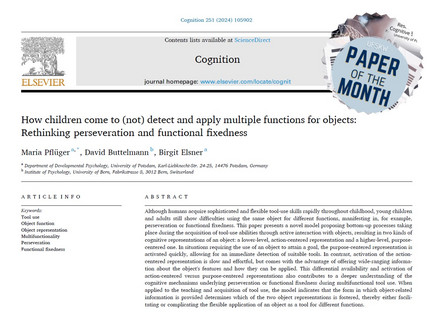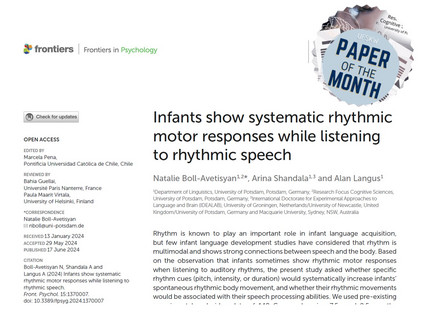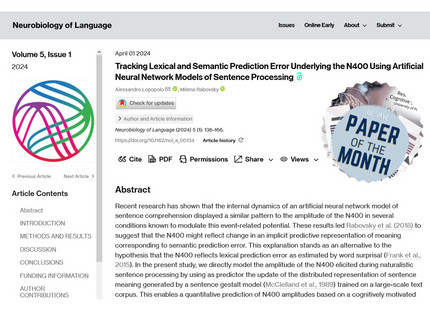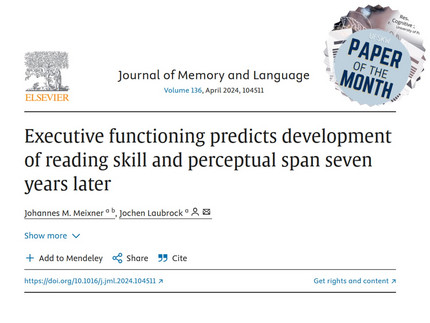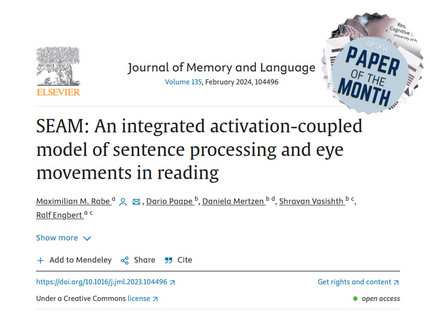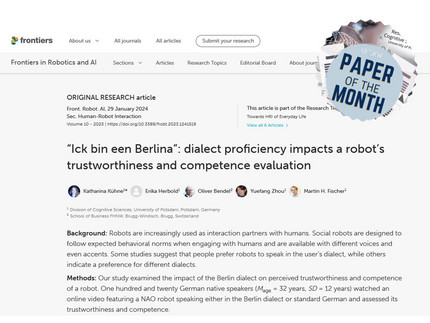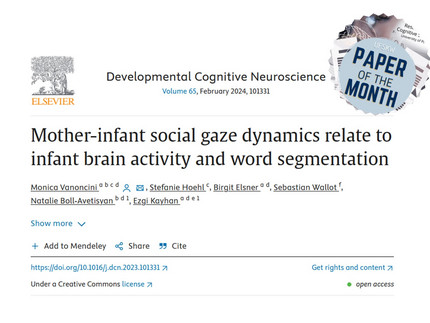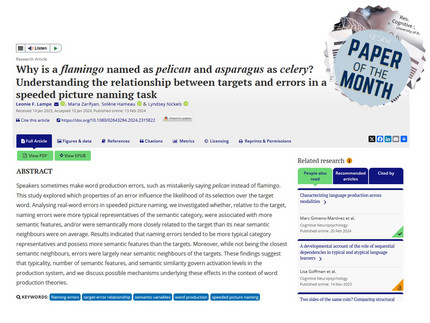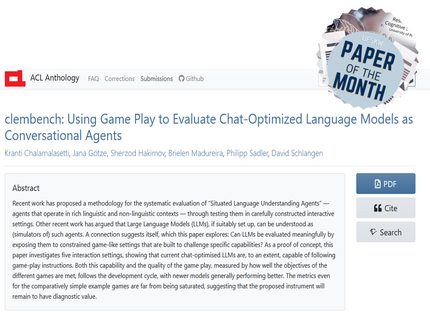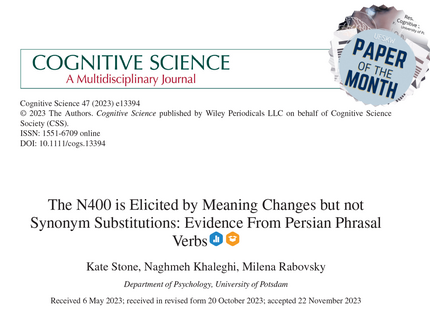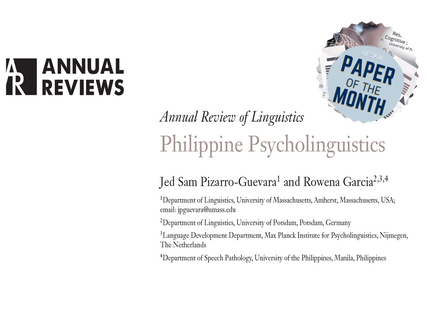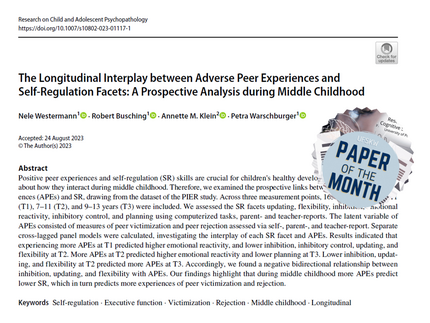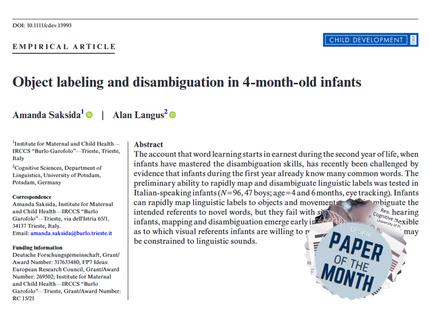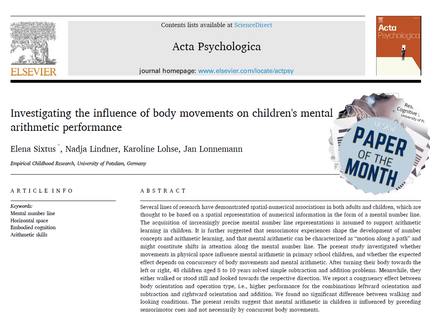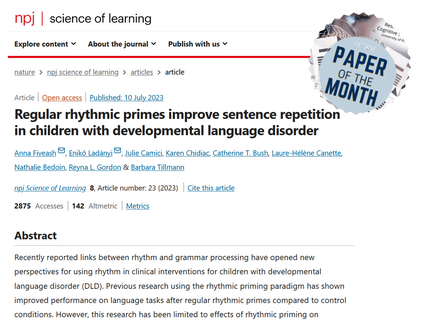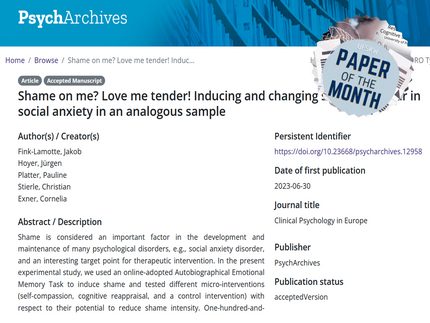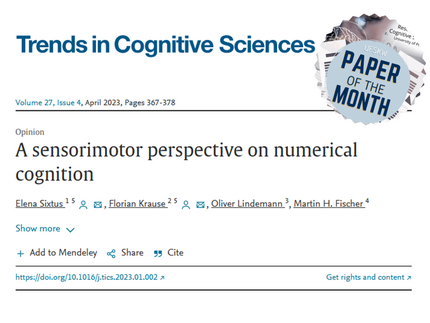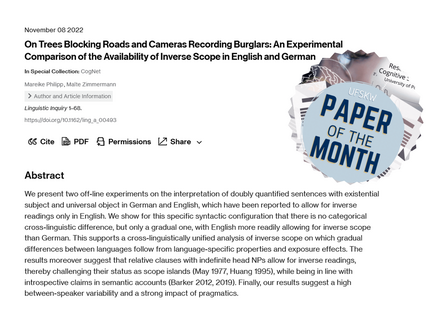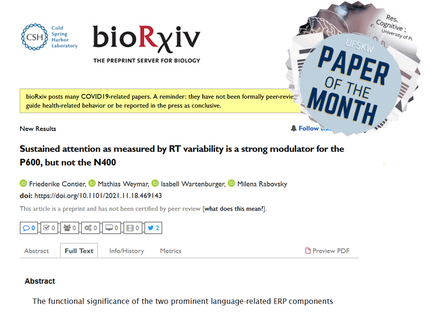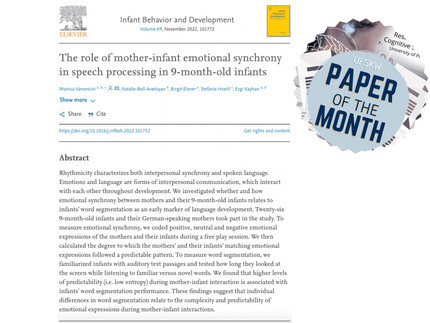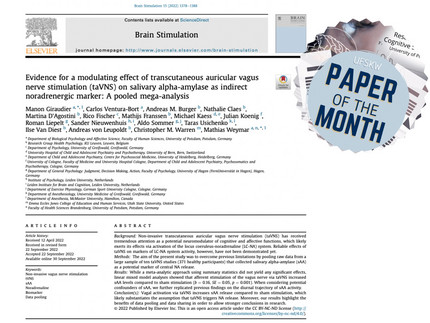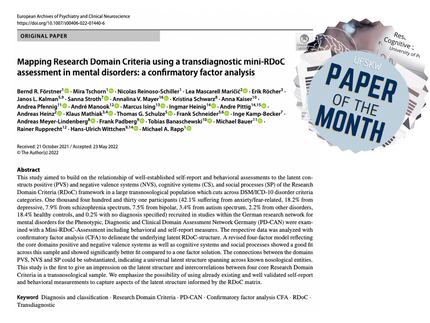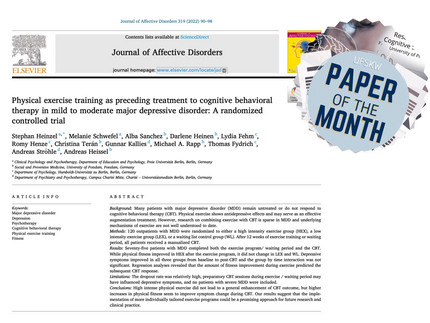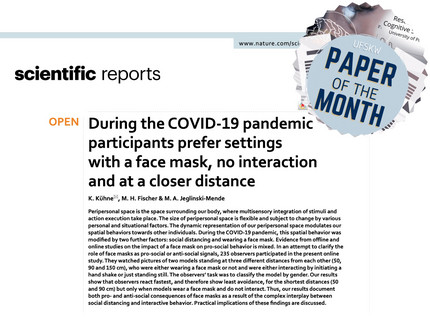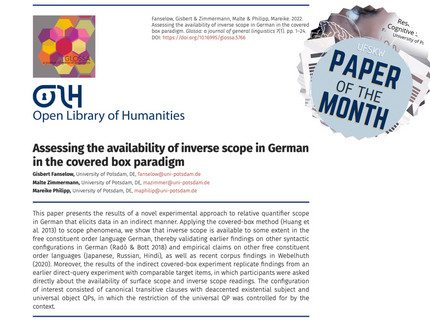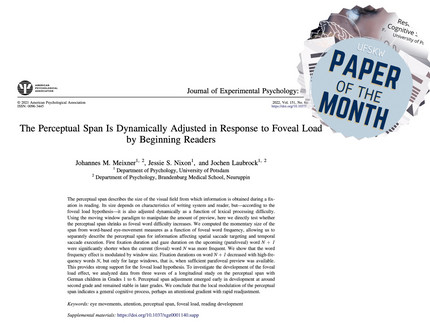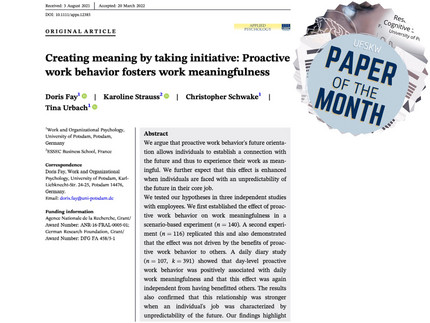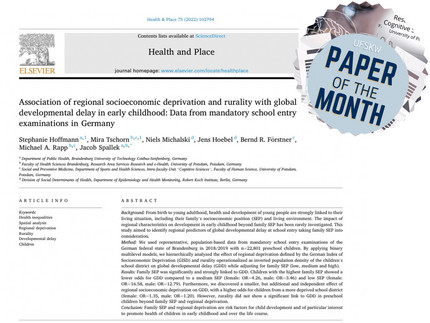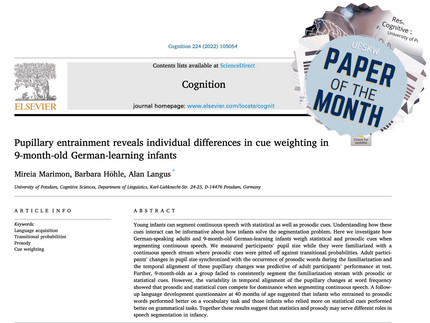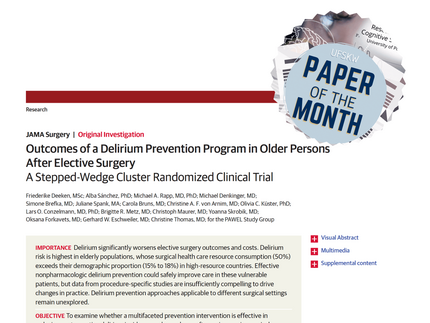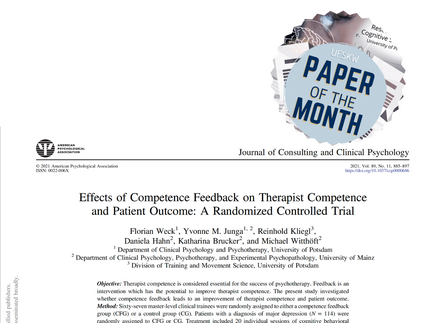RFCS Paper of the Month
The UFSKW Paper of the Month gives a special stage to current cognitive science research from the Research Focus Cognitive Sciences (UFSKW). Beginning in 2021, the Paper of the Month is selected by the Selection Committee on a monthly basis from all submissions.
All members of the Research Focus and/or the UFSKW Postdoc Network can propose their own papers at any time. At least one of the (co-)authors must be a member of the UFSKW or the Postdoc Network.
To propose a paper, members need to send an email to the scientific coordinator, Dr. Raúl Bendezú Araujo (raul.bendezu.araujo at uni-potsdam.de)
Your email should include the following information:
(1) the DOI and (2) a link to the published paper OR to the preprint of the paper (for non-open access articles) and (3) a short comment on what makes your paper special.
Paper of the Month, April
Ready for translation: non-invasive auricular vagus nerve stimulation inhibits psychophysiological indices of stimulus-specific fear and facilitates responding to repeated exposure in phobic individuals
Authors: Christoph Szeska, Kai Klepzig, Alfons O. Hamm & Mathias Weymar
Comment: In our paper, we built upon previous rodent research and examined (for the first time in humans) whether and how the non-invasive stimulation of the vagus nerve may invoke an inhibition of cortically- and subcortically-mediated fear responses in spider phobic patients during in-vivo and in-vitro threat exposure. We not only demonstrate that the non-invasive stimulation of a peripheral nerve attenuates excessive fear on multiple levels of expression and in a long-term manner, but also provide mechanistic evidence that such effect is related to vagally-mediated noradrenergic activation of neural fear extinction circuits.
Our work represents an important milestone to translational neuroscience: Since it was found in animals that invasive vagus nerve stimulation (VNS) has the potential to foster the extinction of conditioned fear by invoking plasticity in the amygdala and prefrontal cortex, it was endeavored to translate this technique to humans. While over the past years a growing body of preclinical human research replicated animal literature and showed, that non-invasive VNS indeed promotes the extinction of conditioned fear, a clinical transfer and thorough mechanistic insights into this technique have been lacking. The findings outlined in our manuscript thus not only extend the growing body of literature on fear extinction mechanisms, but also provide an important link between animal and human research and finally present a promising avenue for the development of novel therapeutic interventions for anxiety disorders.
Paper of the Month, March 2025
Postnatal dependency as the foundation of social learning in humans
Author: Christian Kliesch
Comment: The paper provides a novel conception of the role of infants’ early post-natal environment on the development of human social learning abilities. Rather than appealing to specific cognitive adaptations, it proposes that humans’ unique developmental trajectory limits infants’ ability to explore their environment on their own, and instead provides them with the ability to explore the world through others. As I show in the paper, this developmental trajectory is substantially different to that of other species, including even our closest living relatives. Referring to work in embodied cognition, the paper further suggests that this trajectory puts human infants into a position where they can learn to integrate others and the opportunities for action and exploration into their own sensori-motor representations. Therefore, this paper combines recent perspectives from evolutionary, developmental, and radically embodied perspectives to provide a novel explanation of higher order cognitive skills, such as social learning.
Paper of the Month, February
Bayes Factor vs. Posterior Predictive Model Assessment: Insights from Ordinal Constraints
Authors: Julia M. Haaf, Fayette Klaassen & Jeffrey N. Rouder
Comment: This is a statistical paper comparing two modes of Bayesian inference, Bayes factor and posterior predictive methods. There is a heated discussion among Bayesians on this topic that is ongoing for at least a decade. The novelty of this paper is connecting the debate to theoretical considerations from social sciences, particularly psychology. The key takeaway is: Whenever the to-be-compared models include overlapping ordinal constraints (say a parameter is positive in model 1 but can be positive or negative in model 2), then posterior predictive methods are not able to provide consistent inference, but Bayes factor is. We show in three accessible examples when this might be problematic. I think the paper is an accessible discussion of a complicated statistical issue. There also is a critical philosophical argument: How we specify statistical models should primarily be a matter of theoretical considerations answering a specific research question, not whether the tool of statistical inference can accommodate it. Theory first, statistics second. On a personal note, the paper is special because it took me several years to write it (and especially to revise it).
Paper of the Month, January 2025
German infants’ discrimination of the English /æ/-/ɛ/ contrast: Evidence from a cross-sectional and a longitudinal study
Authors: Hiromasa Kotera, Ghada Khattab, Natalie Boll-Avetisyan & Barbara Höhle
Comment: This study is the first to demonstrate that short-term exposure to non-native sound contrasts can influence the direction of asymmetric perception in infants. We examined German infants’ ability to discriminate the English contrast /æ/ and /ɛ/ at three age ranges: 5-6, 8-9, and 12-13 months, using both cross-sectional and longitudinal approaches. In the cross-sectional group, 5-6-month-olds showed no signs, 8-9-month-olds showed slight signs, and 12-13-month-olds showed significant signs of discrimination. Notably, at 8-9 and 12-13 months, infants discriminated the contrast only when the sound changed from /ɛ/ to /æ/, aligning with previous findings suggesting that changes from central to peripheral vowels in the F1/F2 vowel space are easier to recognize than the reverse (Polka & Bohn, 1996). In the longitudinal group, 5-6- and 8-9-month-olds did not show discrimination, while 12-13-month-olds did, but only when the sound changed from /æ/ to /ɛ/. We propose that the 12-13-month-olds in the longitudinal group began to perceive /æ/ as a non-prototypical version of /ɛ/ due to short-term exposure during the earlier sessions. Previous research suggests that changes from non-prototype to prototype sounds are easier than the reverse (Kuhl, 1991). Results from both cross-sectional and longitudinal groups indicate that discrimination abilities are not robust until the end of the first year. This challenges the classical view of perceptual attunement, which suggests that infants often lose the ability to discriminate non-native contrasts during the first year but aligns with recent findings suggesting that the discrimination of subtle non-native contrasts may be difficult for young infants and requires some language experience.
Paper of the Month, December 2024
Clinical supervision based on video vs. verbal report: a randomized controlled trial
Authors: Florian Weck, Ulrike Maaß, Tatjana Paunov, Peter E. Heinze & Franziska Kühne
Comment: Supervision is a training method designed to enable trainee psychotherapists to treat patients with mental disorders in a professional manner. In this study, the effectiveness of two different supervision methods was investigated in a randomised controlled design. A high degree of standardisation was ensured through the use of simulated patients (people who were trained to present a disorder in a standardised way). A comparison was made as to whether supervision that also included video recordings of the therapy session to be supervised was superior to supervision based solely on the supervisee's report. Both conditions showed an increase in the therapists' therapeutic competence, therapeutic alliance and empathy. No significant differences were found between the conditions. The study emphasises the positive effect of supervision for the training of psychotherapists and therefore has important implications for clinical practice.
Paper of the Month, November 2024
Opposing effects of pre-encoding stress on neural substrates of item and emotional contextual source memory retrieval
Authors: Carlos Ventura-Bort, Janine Wirkner, Julia Wendt, Lars Schwabe, Florin Dolcos, Alfons O. Hamm & Mathias Weymar
Comment: This paper explores how stress experienced before learning influences the brain's mechanisms during memory retrieval. Using functional brain imaging the study found that inducing stress before encoding (learning) increased activity in frontal and parietal brain regions when individual items were retrieved. Conversely, the same pre-encoding stress reduced activity in these regions during the retrieval of emotionally unpleasant contextual information. This suggests that stress can have dual effects on memory: enhancing the retrieval of specific items while impairing the retrieval of emotional contexts, in which those items were learned. These findings are significant because they provide important insights into how stress affects different aspects of memory. Understanding these opposing effects can inform about strategies to mitigate stress-related memory impairments, which is particularly relevant for clinical conditions in which dysfunctional integration of item-context information may play a critical role (e.g.. intrusive and/or fragmented memory reactivations and overgeneralization in stressor- and trauma-related disorders).
Paper of the Month, October 2024
Visual context benefits spoken sentence comprehension across the lifespan
Authors: Carlotta Zona & Jana Reifegerste
Comment: Our paper takes an individual difference approach to investigate the benefits of visual-context information on syntactic comprehension continuously across the adult lifespan and as a function of cognitive abilities. The results highlight that visual information benefits comprehension especially when task demands are high, and that age-related changes in sentence comprehension are modulated by individual cognitive ability levels. These findings contribute to quantifying the role of individual profiles in determining the use of different information sources for syntactic comprehension across the adult lifespan.
Paper of the Month, September 2024
Eye-Movement Suppression in the Visual World Paradigm
Authors: Anna Laurinavichyute, Anastasia Ziubanova & Anastasiya Lopukhina
Comment: The visual world paradigm has been used to study spoken language processing for over 30 years. Our study for the first time tests to what degree eye movement behavior in the visual world paradigm depends on task might be compromised. We discuss some cases where participants could adopt different viewing behaviors depending on the experimental condition, and provide some tentative ways to test for such differences.by probing whether participants could refrain from looking at the referred image. Across two experiments with and without comprehension questions (total N = 159), we found that when participants were instructed to avoid looking at the referred images, the probability of fixating these reduced from 58% to 18% while comprehension scores remained high. Although language-mediated eye movements could not be suppressed fully, the degree of possible decoupling of eye movements from language processing suggests that participants can avoid looking at the referred images when needed. If they do so to different degrees in different experimental conditions, comparisons between conditions might be compromised. We discuss some cases where participants could adopt different viewing behaviors depending on the experimental condition, and provide some tentative ways to test for such differences.
Paper of the Month, August 2024
How children come to (not) detect and apply multiple functions for objects: Rethinking perseveration and functional fixedness
Authors: Maria Pflüger, David Buttelmann & Birgit Elsner
Comment: Based on a review on the current literature on young children's tool use, we present a novel model that describes how object knowledge relevant to the functional use of an object is acquired through exploration and active manipulation. We propose that object-specific representations are built by associating object features with feasible object movements and the resulting action effect(s). We further propose that there are different representations for an object, one focused on object use (action-centered representation) and the other, higher-level representation focused on a potential function of the object (purpose-centered representations). When later situations require using the object as a tool to achieve a given goal, we propose that the object representations are activated, thereby influencing how the object is perceived and manipulated. Our model also provides novel explanations for difficulties that arise when a familiar object is used for a novel function (multifunctional tool use), such as perseveration or functional fixedness.
Paper of the Month, July 2024
Infants show systematic rhythmic motor responses while listening to rhythmic speech
Authors: Natalie Boll-Avetisyan, Arina Shandala & Alan Langus
Comment: Our study is one of the first to look into early speech perception processes through the prism of sensorimotor engagement. In this paper, we explored infants’ spontaneous rhythmic movements while listening to syllable strings with different rhythmic organizations. We reanalyzed data from a previous infant experiment, annotating all rhythmic movements produced by 148 German-learning 7.5- and 9.5-month-olds while they listened to sequences of artificial syllables. As a result, infants moved rhythmically most frequently while listening to syllable strings marked by duration (iambic organization), and, interestingly, differences in motor engagement were present only when they listened to their native, German-sounding language streams. Moreover, we found a link between the frequency of infants' rhythmic movements and their segmentation of the syllable streams: infants who produced less rhythmic movement when listening to the syllables showed more mature segmentation of the streams. This study lays the groundwork for future research into the link between infants’ sensorimotor engagement and their speech perception, as well as individual differences in infants’ rhythmic motor responses to speech and their language abilities.
Paper of the Month, June 2024
Tracking Lexical and Semantic Prediction Error Underlying the N400 Using Artificial Neural Network Models of Sentence Processing
Authors: Alessandro Lopopolo & Milena Rabovsky
Comment: Our paper pioneers a novel approach to understanding the N400, a well-known event-related potential (ERP) in cognitive neuroscience, by leveraging leveraging a large-scale version of an artificial neural network model of sentence processing, the Sentence Gestalt (SG) model. This innovative method bridges the gap between cognitive neuroscience and artificial intelligence, providing new insights into the internal dynamics of sentence comprehension. By directly predicting the amplitude of the N400 using the update of the distributed representation of sentence meaning generated by the SG model, our paper empirically supports the hypothesis that the N400 reflects changes in implicit predictive representations of meaning. This study offers a robust quantitative comparison between the sentence gestalt update measure and lexical surprisal, a popular predictor of the N400 that argues this ERP signals lexical rather than semantic prediction. The comparison highlights the complexity of sentence processing and suggests that N400 amplitudes are influenced by both semantic and lexical factors. These findings enrich our understanding of predictive processing in language comprehension and support the broader predictive processing theory. Furthermore, the integration of cognitive models with large-scale computational techniques demonstrates the potential of combining cognitive theories with advanced computational methods, setting a precedent for future interdisciplinary research. This methodological shift not only provides new tools for cognitive neuroscience but also opens up possibilities for exploring other cognitive phenomena using similar techniques.
Paper of the Month, May 2024
Executive functioning predicts development of reading skill and perceptual span seven years later
Authors: Johannes Meixner & Jochen Laubrock
Comment: This is a report of the complete sample of our longitudinal study of the perceptual span, now including T4 and T5 and following pupils in Brandenburg from grade 1-3 to grade 8-10. The study started in the context of the PIER study, which provided funding for the initial stages. We are grateful to the UFSKW for funding data collection at T4 and T5. Using these data, we show that reading skill and executive functioning (measured using nonreading tests) at the beginning of schooling can predict reading skill and perceptual span size seven years later.
- We analyze longitudinal growth curves of reading and perceptual span development
- Initial differences between children increased in the first years, and then stabilized by the end of school
- Initial executive functioning longitudinally amplified these effects
- The perceptual span depends largely on executive functions, suggesting it is subject to attentional control
- Early tests of reading and executive functions can identify individuals at risk of failing to become efficient readers
Paper of the Month, April 2024
SEAM: An integrated activation-coupled model of sentence processing and eye movements in reading
Authors: Maximilian M. Rabe, Dario Paape, Daniela Mertzen, Shravan Vasishth & Ralf Engbert
Comment: The paper presents the first-ever complete process model of eye-movement control with linguistic dependency completion processes in sentence comprehension. We combine the SWIFT model of eye-movement control (Engbert et al., 2005) with key components of the Lewis and Vasishth sentence processing model (Lewis & Vasishth, 2005). This integration becomes possible due to recent advances in Bayesian parameter identification in dynamical models (Rabe et al., 2021; Seelig et al., 2023). The integrated Sentence-Processing and Eye-Movement Activation-Coupled Model (SEAM) can successfully reproduce eye movement patterns that arise due to similarity-based interference in reading.
Paper of the Month, March 2024
“Ick bin een Berlina”: dialect proficiency impacts a robot’s trustworthiness and competence evaluation
Authors: Katharina Kühne, Erika Herbold, Oliver Bendel, Yuefang Zhou & Martin Fischer
Comment: Our research explored how a robot speaking in the Berlin dialect affects how much people trust it and see it as competent. We had 120 German speakers evaluate a robot talking in Berlin dialect or standard German. People who spoke the dialect well trusted the robot more. Interestingly, being good with the dialect also made them think the standard German-speaking robot was more competent. Our findings have important implications for designing adaptable robots. They make us think about finding the right balance between making a connection and showing competence in human-robot interactions. This could be useful for designing service robots or those used in elderly care facilities.
Paper of the Month, February 2024
Mother-infant social gaze dynamics relate to infant brain activity and word segmentation
Authors: Monica Vanoncini, Stefanie Hoehl, Birgit Elsner, Sebastian Wallot, Natalie Boll-Avetisyan & Ezgi Kayhan
Comment: This paper is special because it examines the dyadic dynamics of mother-infant interaction across modalities (i.e., neural and behavioural) and levels (i.e., intrapersonal and interpersonal) in relation with language learning. For the first time, brain-to-behaviour synchrony is studied during free play through a scientific lens and quantified with the use of a novel method called joint Recurrence Quantification Analysis. The results are going to put the field forward because of the role that caregiver plays in the activity of their infant’s ‘social brain’, relating also to the infant’s word-segmentation ability.
This study used functional near-infrared spectroscopy (fNIRS) to measure the ‘social brain’ activity of infants and behavioural micro-coding for mother’s and infant’s social gaze during 5 minutes of free play. In addition, we assessed infants' word segmentation abilities with an eye-tracking task. Data showed that the coordination of maternal social gaze was significantly more strongly related with the infants' ‘social brain’ activity than infant's coordination or dyadic coupling of social gaze. Additionally, the coordination of maternal social gaze was the best predictor of infants' word segmentation abilities. These findings emphasise the relation between the coordination of maternal social gaze and infants’ linguistic skills, which we speculate to be mediated by infants’ attention. Remarkably, our results support the dynamic and interactive perspective when investigating early cognitive and language development. The dyadic dynamics that emerge from caregivers-infants shared interaction might structure potential learning situations, increase and guide the infant’s attention, and can thereby influence early language acquisition and its individual variability. Finally, our study used advanced techniques such as fNIRS to measure cortical activity and applied a new method, joint Recurrence Quantification Analysis, which could pave the way for innovative research questions on the dynamics of naturalistic interactions.
Paper of the Month, January 2024
Why is a flamingo named as pelican and asparagus as celery? Understanding the relationship between targets and errors in a speeded picture naming task
Authors: Leonie Lampe, Maria Zarifyan, Solène Hameau & Lyndsey Nickels
Comment: This paper is based on the first master thesis I (Leonie) supervised (Maria Zarifyan, EMCL+). After entirely rewriting the thesis, I am proud that this paper is now part of a special issue on Language Production in Cognitive Neuropsychology. In the paper we used a novel approach to analysing spoken real-word naming errors produced by a large group of neurotypical participants (n = 78) under time pressure. Specifically, we investigated the relationship between the intended target word and the erroneously produced incorrect response with regard to various psycholinguistic variables. This allowed us to uncover the mechanisms that cause participants to incorrectly say pelican but not emu when attempting to name a picture of a flamingo. This novel approach to naming errors allowed us to scrutinise current theories of word production and of lexical-semantic organisation and to propose necessary amendments for these theories to be able to account for our findings.
Paper of the Month, December 2023
clembench: Using Game Play to Evaluate Chat-Optimized Language Models as Conversational Agents
Authors: Kranti Chalamalasetti, Jana Götze, Sherzod Hakimov, Brielen Madureira, Philipp Sadler & David Schlangen
Comment: This paper is the first to propose a measuring framework for testing large language models (LLMs) as interactive, dynamic agent models. LLMs have shown impressive abilities in the last years, but this impression often comes from unsystematic testing and anecdotal evidence. This paper sets up a systematic testing framework for interactive tasks (framed as conversational "games"), implements various such games targetted at different interactional capabilities, and tests a large variety of LLMs. The results show that the best commercial models show beginnings of agentive abilities (and are much better than current open-weight models), but still decidedly fall short of human performance.
The N400 is elicited by meaning changes but not synonym substitutions: Evidence from Persian phrasal verbs
Authors: Katherine Stone, Naghmeh Khaleghi & Milena Rabovsky
Comment: The paper compares unexpected words in a sentence, one a synonym of the most expected word based on the context, the other a word that changes the expected meaning. Between the two equally unexpected words, only the word that changed the meaning of the sentence triggered an N400. This suggests that the N400 is more attuned to meaning than the specific form of a word. Some nice features of the paper are that it uses Persian---the diaspora in Berlin and Potsdam were very excited to participate!---and has open data and code.
Paper of the Month, November 2023
Philippine Psycholinguistics
Authors: Jed Sam Pizarro-Guevara & Rowena Garcia
Comment: My co-author and I had been invited to write this review, and we took this challenge thinking about what could have helped our younger researcher selves in starting to conduct studies on Philippine languages. We are proud of this paper because we think it is a good entry point for those in formal linguistics and related fields to know more about the few psycholinguistic studies that have already been done in Philippine languages, and for those in psycholinguistics to know more about the interesting properties of this language group. This paper will hopefully encourage and make it easier for researchers to investigate these understudied languages. I am additionally proud because in this paper, we could showcase our own studies from the University of Potsdam, which are pioneering work on children’s acquisition of Tagalog.
Link: https://doi.org/10.1146/annurev-linguistics-031522-102844
Paper of the Month, October 2023
The Longitudinal Interplay between Adverse Peer Experiences and Self-Regulation Facets: A Prospective Analysis during Middle Childhood
Authors: Nele Westermann, Robert Busching, Annette M. Klein & Petra Warschburger
Comment: Positive peer experiences and self-regulation (SR) skills are crucial for children's healthy development, but little is known about how they interact during middle childhood. Therefore, we examined the prospective links between adverse peer experiences (APEs) and SR, drawing from the dataset of the PIER study. Across three measurement points, 1654 children aged 6–11 (T1), 7–11 (T2), and 9–13 years (T3) were included. We assessed the SR facets updating, flexibility, inhibition, emotional reactivity, inhibitory control, and planning using computerized tasks, parent- and teacher-reports. The latent variable of APEs consisted of measures of peer victimization and peer rejection assessed via self-, parent-, and teacher-report. Separate cross-lagged panel models were calculated, investigating the interplay of each SR facet and APEs. Results indicated that experiencing more APEs at T1 predicted higher emotional reactivity, and lower inhibition, inhibitory control, updating, and flexibility at T2. More APEs at T2 predicted higher emotional reactivity and lower planning at T3. Lower inhibition, updating, and flexibility at T2 predicted more APEs at T3. Accordingly, we found a negative bidirectional relationship between inhibition, updating, and flexibility with APEs. Our findings highlight that during middle childhood more APEs predict lower SR, which in turn predicts more experiences of peer victimization and rejection.
Paper of the Month, September 2023
Object labeling and disambiguation in 4-month-old infants
Authors: Amanda Saksida & Alan Langus
Comment: Word learning is generally thought to start around infants’ first birthday. However, recent studies suggest that infants as young as 6-months-of-age already know some common words. In this paper, we investigate whether some of the abilities necessary for word learning could therefore be present during the first months of life. Specifically, we test whether 4-month-old infants can rapidly associate linguistic labels to visual referents and whether they show some preliminary evidence for mutual exclusivity: i.e., the ability to disregard objects that have already been named as potential referents for novel words. In 4 experiments, we show that 4-month-old infants can associate a nonce word to an object or its movement after a single brief exposure. We also show that infants will subsequently ignore the object and movement for which they have learned the word as a referent for other novel words. This shows that some of the core abilities for word learning are present before infants know the meaning of any words. Importantly, we also show that these early word-learning abilities only work with linguistic sounds (i.e., nonce words), but not with non-linguistic sounds that have the complexity of spoken language (i.e., sinewave speech). Our results suggest that the ability to acquire words emerges much earlier in development than previously thought, and that the mechanisms infants use for word-learning are specific to spoken language.
Paper of the Month, August 2023
Investigating the influence of body movements on children's mental arithmetic performance
Authors: Elena Sixtus, Nadja Lindner, Karolina Lohse & Jan Lonnemann
Comment: The development of number concepts and arithmetic learning are presumably shaped by sensorimotor experiences. Previous literature characterized mental arithmetic as “motion along a path”, where it might constitute shifts in attention along a mental number line. The present study investigates whether movements in physical space influence mental arithmetic in primary school children, and whether the expected effect depends on concurrency of body movements and mental arithmetic. After turning their body towards the left or right, 48 children aged 8 to 10 years solved simple subtraction and addition problems. Meanwhile, they either walked or stood still and looked towards the respective direction. We report a congruency effect between body orientation and operation type, i.e., higher performance for the combinations leftward orientation and subtraction and rightward orientation and addition. We found no significant difference between walking and looking conditions. The present results suggest that mental arithmetic in children is influenced by preceding sensorimotor cues and not necessarily by concurrent body movements.
Paper of the Month, July 2023
Regular rhythmic primes improve sentence repetition in children with developmental language disorder
Authors: Anna Fiveash, Enikő Ladányi, Julie Camici, Karen Chidiac, Catherine T. Bush, Laure-Hélène Canette, Nathalie Bedoin, Reyna L. Gordon & Barbara Tillmann
Comment: Our study shows the first time that listening to a rhythm with a regular beat improves sentence repetition performance in children with developmental language disorder and with typical development. These results extend previous findings on the facilitative effect of a regular rhythm on grammaticality judgment task performance, and support the view that the structures of musical rhythm and linguistic grammar are processed by shared underlying mechanisms. The findings also motivate future clinical research on the integration of rhythmic stimulation in traditional speech-language therapy to facilitate the treatment of children with developmental language disorder.
Paper of the Month, June 2023
Shame on me? Love me tender! Inducing and changing shame and fear in social anxiety in an analogous sample
Authors: Jakob Fink-Lamotte, Jürgen Hoyer, Pauline Platter, Christian Stierle & Cornelia Exner
Comment: This paper stands out by validating an online-adopted Autobiographical Emotional Memory Task to induce shame in 115 healthy subjects. Further the results indicate that self-compassion showed a significantly larger reduction in shame compared to an active control condition, with interactions influenced by trait social anxiety and trait self-compassion. These promising findings highlight the value of self-compassion interventions in alleviating intense shame experiences and call for further research in the field.
Paper of the Month, May 2023
Gaze patterns reflect and predict expertise in dynamic echocardiographic imaging
Authors: Jochen Laubrock, Alexander Krutz, Jonathan Nübel& Sebastian Spethmann
Comment: Dynamic echocardiography – ultrasound movies of the heart – is the most important imaging method for judging heart function. We temporarily set up our eyetracking lab at Charité to observe experts when viewing such ultrasound movies of patients and healthy controls, and compared them to a group of beginning medical students. Using signal detection measures we show that experts are indeed much better in diagnosing the health status. Eyetracking reveals that this is because experts focus their attention on diagnostically relevant regions, whereas students are distracted by salient but diagnostically irrelevant moving elements such as the mitral valve. Using machine learning, we identified the most relevant predictors from gaze data and built a predictive model from which we derive a numerical expertise score that can be used in education and assessment. Results may further be useful for the design of echocardiography user interfaces.
Paper of the Month, April 2023
A sensorimotor perspective on numerical cognition
Authors: Elena Sixtus, Florian Krause, Oliver Lindemann, Martin Fischer
Comment: With this paper we aim to unify existing knowledge in the field of embodied numerical cognition and reconcile it with more traditional accounts. Numerical information is usually encountered in one of three symbolic formats: number words (e.g. “seven”), numerals (e.g. “7”) and sensorimotor symbols (e.g. holding up 7 fingers). But how does this information become meaningful to us? From an embodied cognition perspective, conceptual knowledge becomes meaningful by relating it to sensorimotor experiences with physical entities in the world. We argue that number symbols evoke not one but three distinct underlying semantic concepts: magnitude (continuous amount), ordinality (position in a sequence) and cardinality (discrete amount). We propose that number comprehension and numerical proficiency emerge from differently grounding these three numerical core concepts in (multiple) sensorimotor experiences. We discuss potential implications for education and treatment/prevention of numerical deficits, and we hope that this proposal stimulates further discussion as well as future research.
Paper of the Month, March 2023
Music and language in the crib: Early cross-domain effects of experience on categorical perception of prominence in spoken language
Authors: Alan Langus, Natalie Boll-Avetisyan, Sandrien van Ommen & Thierry Nazzi
Comment: Die vorliegende Studie zeigt erstmals, dass frühkindliche Musikerfahrung im Elternhaus im Zusammenhang mit Sprachwahrnehmungfähigkeiten im Babyalter steht. Außerdem ist sie die erste, die demonstriert, das Wortbetonung mittels kategoriellen Wahrnehmungsfiltern verarbeitet wird. Die Psycholinguistik stellt seit einigen Jahren vermehrt die Frage, inwieweit nichtsprachliche Erfahrung Sprachverarbeitungsprozesse beeinflusst. So konnte die Forschung mit Erwachsenen zeigen, dass Musikerfahrung zu höheren Sprachleistungen führt – vor allem auf der Ebene der Prosodie. Unerforscht war bisher, ob Säuglinge in der frühen Phase des Spracherwerbs von musikalischem Input im Elternhaus profitieren. In unserer Studie fragten wir Eltern von sechsmonatigen Babys, ob und wie häufig zuhause Instrumente gespielt, Lieder gesungen und Kinderbücher vorgelesen wurden. Außerdem sollten die Eltern ihre Musikalität einschätzen und wie melodisch sie mit ihrem Kind sprachen. Per Eyetracking maßen wir die Pupillengröße der Babys in Reaktion auf Nichtwörter, die sich prosodisch in der Wortbetonung auf einem akustischen Kontinuum kategorisch (GAba vs gaBA) oder nur akustisch (GAba vs GAba) oder gar nicht (GAba vs GAba) unterschieden. Auf Gruppenebene fanden wir keine Reaktion auf Betonungsunterschiede. Jedoch zeigten diejenigen Babys mit überdurchschnittlicher kindgerichteter Musik- und Spracherfahrung starke Effekte der kategoriellen Wahrnehmung: Ihre Pupillen reagierten deutlich auf Betonungsunterschiede (GAba vs gaBA), aber nicht auf akustische Unterschiede. Interessanterweise waren kindgerichtete musikalische und sprachliche Aktivitäten der Eltern nicht korreliert. Augenscheinlich legen die meisten Eltern entweder auf musikalischen oder sprachlichen Input wert. Dennoch war es genau die Kombination aus beidem, die Babys mit starken Prosodiewahrnehmungsfähigkeiten erfahren hatten. Da die Prosodie ein wichtiger Wegbereiter für den Aufbau von Lexikon und Syntax ist, ist der vorliegende Befund zentral für die Spracherwerbsforschung: Sollte der Spracherwerbsverlauf tatsächlich positiv von musikalischen Aktivitäten beeinflusst werden können, wäre dies fundamental für unser Verständnis der Rolle von Erfahrung in kognitiven Prozessen und könnte Anwendungspotential in Erziehung und Bildung bergen.
Paper of the Month, February 2023
Space-valence mapping of social concepts: Do we arrange negative and positive ethnic stereotypes from left to right?
Authors: Katharina Kühne, Kristina Nenaschew & Alex Miklashevsky
Comment: Unser Körper trägt mehr zu unserer Kognition bei, als wir gewöhnlich annehmen. Die Körperspezifitätshypothese besagt beispielsweise, dass Rechtshänder*innen positive Konzepte mit der rechten Seite und negative Konzepte mit der linken Seite des Körpers assoziieren. Dieses Phänomen wurde mit verschiedenen Reizen nachgewiesen: Musikstücke, Zeichnungen und sogar Lebensmittel. Allerdings wurde sozialen Konzepten, wie z. B. Stereotypen, bisher wenig Aufmerksamkeit geschenkt. Dabei haben negative Stereotypen gegenüber Ethnien, Geschlechtern oder bestimmten anderen Gruppen weitreichende Folgen für persönliche Entscheidungen und die gesamte Gesellschaft. In Anlehnung an die Körperspezifitätshypothese postulierten wir, dass negative ethnische Stereotypen gegenüber einer Fremdgruppe mit der linken Seite und positive Stereotypen gegenüber der eigenen Gruppe mit der rechten Seite assoziiert werden. Unser Ziel war es, diese Zuordnung von Stereotypen im horizontalen Raum mit einer impliziten Aufgabe zu finden, die frei von den Nachteilen bisheriger Methoden ist. Wir dachten auch an mögliche Interventionen zur Änderung impliziter Einstellungen durch Manipulation des Raumparameters. Zum ersten Mal verwendeten wir sprachliche Reize, um diese Assoziation zu bewerten. Zunächst haben wir mit einem Impliziten Assoziationstest die positiven bzw. negativen Stereotypen deutscher Studierenden gegenüber Deutschen bzw. Arabern gemessen. Dann baten wir dieselben Teilnehmer*innen, Sätze mit arabischen und deutschen Namen durch Drücken der linken oder rechten Taste als sinnvoll oder nicht sinnvoll zu bewerten. Überraschenderweise konnten wir keine Zuordnung von negativen und positiven Stereotypen auf der horizontalen Dimension finden. Wahrscheinlich werden Stereotypen aufgrund ihrer komplexen Struktur oder ihrer abstrakten Verarbeitungsebene nicht automatisch mit der linken oder rechten Seite des Körpers assoziiert. Diese Studie ist einer der ersten Schritte zum Verständnis der Verkörperung komplexer sozialer Konstrukte.
Paper of the Month, January 2023
On Trees Blocking Roads and Cameras Recording Burglars: An Experimental Comparison of the Availability of Inverse Scope in English and German
Authors: Mareike Philipp & Malte Zimmermann
Comment: In this paper, we present a cross-linguistic investigation of English and German regarding the phenomenon of quantifier scope ambiguites in doubly-quantified sentences. The literature offers specific claims about the cross-linguistic pattern: only English is predicted to give rise to this type of ambiguities in the sentence types we investigated, while German is not, due to its free word order (e.g. Frey 1993, Bobaljik & Wurmbrand 2012). In order to test this cross-linguistic prediction, we ran the same experiment in both English and German. We further tested the impact of two factors in each language: embedding and plausibility. The relevance of this paper is characterized by novel experimental data, which contradicts two important claims in the literature: (i) German is not categorically different from English and allows for inverse readings, despite its free worder; (ii) a relative clause embedding does not fully block inverse readings in either language, contra longstanding wisdom (e.g. May 1977, Huang 1995). The paper is therefore of major theoretical relevance: Observation (i) supports a cross-linguistically unified analysis of the phenomenon of quantifier scope and its underlying mechanism, with language-specific properties resulting in gradual rather than categorical differences between languages. Observation (ii) challenges the status of relative clauses as scope islands and suggests that semantic approaches to inverse readings might in fact be more adequate than the more popular syntactic approach of Quantifier Raising (May 1977, 1985). The experiments further show that plausibility considerations play a major role in scope resolution and that speakers of the same language follow different resolution strategies.
Paper of the Month, December 2022
Sustained attention as measured by RT variability is a strong modulator for the P600, but not the N400
Authors: Friederike Contier, Mathias Weymar, Isabell Wartenburger & Milena Rabovsky
Comment: Two components of the event-related potential (ERP) observed during sentence processing, N400 and P600, play an important role for neurocognitive models of language comprehension. The N400 is sensitive to the semantic fit of a word, whereas the P600 is typically elicited by structural violations. However, their functional significance is still under debate. In this study, we tested whether the two components vary with the degree of sustained attention, using reaction time variability as a continuous, online read-out of sustained attention over the course of a sentence comprehension task. We found a negative effect of reaction time variability on the P600: Amplitudes were larger in periods of low reaction time variability (high sustained attention) compared to periods of high reaction time variability (low sustained attention). In contrast, the degree of reaction time variability did not affect the amplitude of the N400. Our results provide novel insights into the cognitive processes underlying the two components: Since executive resources necessary for controlled – but not for automatic – processes are only available under sustained attention, results suggest that the P600 component reflects more controlled, and the N400 more automatic processes during sentence processing. Further, this study was the first attempt at adopting the index of reaction time variability from other areas in cognitive neuroscience, thus showcasing its further potential as a continuous measure to monitor fluctuations in sustained attention in psycholinguistic research.
Link: https://www.biorxiv.org/content/10.1101/2021.11.18.469143v2
Paper of the Month, November 2022
The role of mother-infant emotional synchrony in speech processing in 9-month-old infants
Authors: Monica Vanoncini, Natalie Boll-Avetisyan, Birgit Elsner, Stefanie Hoehl, & Ezgi Kayhan
Comment: Rhythmicity, namely a sequence’s tendency to recur, generates predictability and characterizes both mother-infant interactions and spoken language. High predictability in a certain aspect drives a selective sensitivity to that aspect of the environment, compared to other less predictable aspects. In this paper, we target the question of whether predictability of the environment creates an ideal language learning environment for infants. Specifically, we investigated whether the degree of predictability of behaviours in mother-infant interaction was linked to infants’ ability to segment words from fluent speech. To do so, here, we focused on synchrony in mothers’ and infants’ emotions creating a predictability of recurrence of emotional states: we coded both mother’s and infant’s facial expressions with a sampling rate of 40 msec during five minutes of free play. Emotional synchrony was defined as the time in which mother and infant matched their facial expression. Infant’s word segmentation was separately examined with an eye-tracking paradigm. We found that higher levels of emotional predictability during mother-infant interaction was associated with a more advanced infants’ performance in word segmentation. These findings suggest that predictable sequences of facial expressions, potentially allowing infants’ brains to be more efficient, may help infants to detect rhythms in social exchanges as well as in the spoken language. For the first time, our study provides a clear foundation for understanding the role of experience of synchrony and predictability in social interactions in language development, which raises important questions to be addressed by future research. Importantly, the results highlight that we will better understand the causes of individual variation in language development if we consider that language acquisition happens in social interactions – a point that has been neglected in the past.
Paper of the Month, October 2022
Evidence for a modulating effect of transcutaneous auricular vagus nerve stimulation (taVNS) on salivary alpha-amylase as indirect noradrenergic marker: A pooled mega-analysis
Authors: Manon Giraudier, Carlos Ventura-Bort, Andreas M. Burger, Nathalie Claes, Martina D'Agostini, Rico Fischer, Mathijs Franssen, Michael Kaess, Julian Koenig, Roman Liepelt, Sander Nieuwenhuis, Aldo Sommer, Taras Usichenko, Ilse Van Diest, Andreas von Leupoldt, Christopher M. Warren, & Mathias Weymar
Comment: Die transkutane aurikuläre Vagusnervstimulation (taVNS) ist eine Weiterentwicklung der konventionellen und invasiven Vagusnervstimulation, und ermöglicht die Stimulation des Vagusnervs auf nicht-invasive Weise. Es gibt zahlreiche Hinweise auf eine modulierende Rolle der taVNS auf kognitive und affektive Hirnprozesse, die vermutlich durch die Aktivierung des Locus Coeruleus-Noradrenalin (LC-NA) Systems vermittelt wird. Zuverlässige Effekte der taVNS auf Marker der Aktivität des LC-NA Systems konnten bisher jedoch nicht nachgewiesen werden. In diesem Kollaborationsprojekt wurden Daten aus unterschiedlichen nationalen und internationalen Laboren (insgesamt 10 Studien mit N = 381), die die Auswirkungen der taVNS auf die Speichel-Alpha-Amylase, ein mutmaßlicher Marker für noradrenerge Aktivität, untersucht haben, zusammengeführt. Lineare gemischte Modell-Analysen mit einer Vielzahl von Modellierungsansätzen zeigten, dass die afferente Stimulation des Vagusnervs über taVNS die Speichel-Alpha-Amylase im Vergleich zur Scheinstimulation erhöhte, was die Annahme unterstützt, dass taVNS eine NA-Freisetzung auslöst. Der tageszeitliche Verlauf der Alpha- Amylase-Aktivität im Speichel konnte ebenfalls repliziert werden. Somit weist dieses Paper auf eine Aktivierung des LC-NA Systems durch taVNS und den potenziellen Nutzen von Speichel- Alpha-Amylase als nicht-invasiven, kostengünstigen und indirekten noradrenergen Marker im Rahmen der taVNS-Forschung hin. Darüber hinaus verdeutlichen unsere Ergebnisse die Vorteile des "Data Pooling", d.h. des offenen Datenaustauschs, sowie den Einsatz verschiedener statistischer Methoden mit dem Ziel der Veröffentlichung aussagekräftigerer und wertvollerer Ergebnisse. Der Open-Science Ansatz steht dabei im Mittelpunkt dieses Kollaborationsprojekts und beinhaltet die Präregistrierung der Hypothesen, Methoden und Analysen und den offenen Zugang zu allen Forschungsdaten und Analysen.
Papers of the Month, September 2022
Mapping Research Domain Criteria using a transdiagnostic mini‐RDoC assessment in mental disorders: a confirmatory factor analysis
Authors: Bernd R. Förstner, Mira Tschorn, Nicolas Reinoso‐Schiller, Lea Mascarell Maričić, Erik Röcher, Janos L. Kalman, Sanna Stroth, Annalina V. Mayer, Kristina Schwarz, Anna Kaiser, Andrea Pfennig, André Manook, Marcus Ising, Ingmar Heinig, Andre Pittig, Andreas Heinz, Klaus Mathiak, Thomas G. Schulze, Frank Schneider, Inge Kamp‐Becker, Andreas Meyer‐Lindenberg, Frank Padberg, Tobias Banaschewski, Michael Bauer, Rainer Rupprecht, Hans‐Ulrich Wittchen, & Michael A. Rapp
Comment: Ziel dieser Studie aus dem BMBF geförderten Forschungsprojekt PD-CAN im deutschen Forschungsnetzwerk für „Psychische Erkrankungen“ (https://fzpe.de/) war es, die latenten Konstrukte aus der Research Domain Criteria (RDoC)-Initiative des National Institute for Mental Health (NIMH) (https://www.nimh.nih.gov/research/research-funded-by-nimh/rdoc) an einer transnosologischen Population zu untersuchen. Hierfür wurden bereits etablierte Selbsteinschätzungsinstrumente und Verhaltensbeurteilungen in einem Mini-RDoC-Assessment verwendet um die Konstrukte positives (PVS) und negatives Valenzsystemen (NVS), kognitive Systeme (CS) und soziale Prozesse (SP) abzubilden.
Die Daten von 1431 TeilnehmerInnen wurden in einer konfirmatorischen Faktorenanalyse (CFA) analysiert, um die zugrunde liegende latente RDoC-Struktur zu belegen. Das Vier-Faktoren-Modell, der Kerndomänen PVS und NVS sowie CS und SP zeigte, auch im Vergleich zu einem 1-Faktor-Modell, einen guten Model-Fit in dieser Stichprobe. Die Verbindungen zwischen den Domänen PVS, NVS und SP konnten nachgewiesen werden, was auf eine universelle latente Struktur hindeutet, die sich über bekannte nosologische Kategorien hinweg erstreckt.
Diese Studie lässt also einen ersten Einblick auf die latente Struktur und die Interkorrelationen zwischen den vier zentralen RDoC (Kriterien) in einer transnosologischen Stichprobe zu. Wir möchten dabei betonen, dass bereits existierende und gut validierte Selbsteinschätzungsfragebögen und Verhaltensmessungen zur Erfassung von Aspekten der latenten Struktur verwendet werden können. Diese Grundlagenforschung eröffnet uns die Möglichkeit das Wesen von psychischer Gesundheit bzw. Krankheit im Hinblick auf unterschiedliche Grade der Dysfunktion in grundlegenden psychologischen/biologischen Systemen besser zu verstehen.
Physical exercise training as preceding treatment to cognitive behavioral therapy in mild to moderate major depressive disorder: A randomized controlled trial
Authors: Stephan Heinzel, Melanie Schwefel, Alba Sanchez, Darlene Heinen, Lydia Fehm, Romy Henze, Christina Terán, Gunnar Kallies, Michael A. Rapp, Thomas Fydrich, Andreas Ströhle, & Andreas Heissel
Comment: Many patients with major depressive disorder (MDD) remain untreated or do not respond to cognitive behavioral therapy (CBT). Physical exercise shows antidepressive effects and may serve as an effective augmentation treatment. However, research on combining exercise with CBT is sparse in MDD and underlying mechanisms of exercise are not well understood to date. IN this study high intense physical exercise did not lead to a general enhancement of CBT outcome, but higher increases in physical fitness seem to improve symptom change during CBT. Our results suggest that the implementation of more individually tailored exercise programs could be a promising approach for future research and clinical practice.
Paper of the Month, August 2022
During the COVID‐19 pandemic participants prefer settings with a face mask, no interaction
and at a closer distance
Authors: Katharina Kühne, Martin H. Fischer, & Melinda A. Jeglinski
Comment: Diese Studie betrachtet die Wahrnehmung von Sicherheitsmaßnahmen, welche im Rahmen der Covid-19-Pandemie eingeführt und umgesetzt worden sind. Die Testung fand im Frühjahr 2021 statt während der dritten Covid-19-Pandemie-Welle in Deutschland. Die Studie ist relevant, um zu messen, ob die Bevölkerung die empfohlenen Schutzmaßnahmen, Abstand halten, Maske tragen und physische Interaktion vermeiden, verinnerlicht hat.
Die Ergebnisse unserer Studie zeigen, dass die Testpersonen eine mittlere Distanz (90 cm) über einer engen Distanz (50 cm) zweier Personen, die sie auf einem Bild sehen, bevorzugen. Dies ist in Einklang mit den herrschenden Covid-19-Schutzmaßnahmen, nämlich, dass die Nähe zwischen zwei Personen eine Gefahr darstellt. Weiterhin hat unsere Studie gezeigt, dass die Versuchspersonen Bilder ohne soziale Interaktion (Hände schütteln) gegenüber sozialer Interaktion bevorzugen. Auch dies ist in Einklang mit den herrschenden Schutzmaßnahmen, dass körperlicher Kontakt vermieden werden soll. Zudem bestätigen unsere Ergebnisse weiterhin, dass die Atemschutzmaske soziale Interaktion erleichtert, da die Versuchspersonen Bilder von Individuen mit Atemschutzmasken bevorzugten. Unsere Ergebnisse zeigen daher, dass die empfohlenen Schutzmaßnahmen während der Pandemie von unseren Versuchspersonen verinnerlicht und bevorzugt worden sind.
Wir haben diese Ergebnisse erhalten, indem wir die Reaktionszeiten auf die Bilder gemessen haben in einer einfachen Entscheidungs-Aufgabe (das Geschlecht der Personen auf den Bildern entscheiden). Aus ethischen Gründen war er nicht möglich (Ansteckungsgefahr), unsere Versuchspersonen im Labor zu testen und reale soziale Interaktion zu messen. Dies bedeutet, dass die Versuchspersonen diese Ergebnisse aus einer Dritte-Person-Perspektive heraus gezeigt haben. Dies verdeutlicht, wie sehr diese die empfohlenen Schutzmaßnahmen, Maske tragen, Abstand halten, keine physische Interaktion verinnerlicht haben: Obgleich sie nur andere Personen auf den Bildern bei den respektiven Handlungen beobachtet haben, sind implizite Vorlieben, die die Schutzmaßnahmen favorisieren, deutlich geworden. Dies zeigt, wie stark neue soziale Parameter bereits nach einem Jahr in unserem Habitus sind.
Paper of the Month, July 2022
Assessing the availability of inverse scope in German in the covered box paradigmAssessing the availability of inverse scope in German in the covered box paradigm
Authors: Gisbert Fanselow, Malte Zimmermann, & Mareike Philipp
Comment: In this paper, we provide an experimental investigation of how speakers of German interpret doubly-quantified sentences. This type of sentences is of particular interest to the field of linguistics, as they can give rise to ambiguities. The relevance of this paper is characterized by both methodological and theoretical insights. Methodologically, the paper stands out in that it is the first experimental study on inverse scope in German employing a covered box design. Thereby it shows that this method is cross-linguistically suitable for examining scope ambiguities. Results from more direct surveys (yes/no answers to direct content questions) could be replicated here with a more indirect method. Since indirect methods are preferable to more direct ones in studies with naive speakers, these results make a relevant contribution to future experimental research in this area. Furthermore, the experimental results are relevant for theory building, as they underpin (i) that doubly-quantified sentences of the type investigated in here give rise to ambiguities in German, contrary to what is often assumed; (ii) that the availability of different scope interpretations is not categorically regulated by a macroparameter between languages, as has been proposed, but is gradual in nature; (iii) that even within a particular language, scope ambiguities are not a one-dimensional phenomenon that is strictly encoded in the grammar, but is characterized by great variation between speakers and items and therefore depends on a wide range of linguistic and cognitive factors.
Paper of the Month, June 2022
The Perceptual Span Is Dynamically Adjusted in Response to Foveal Load by Beginning Readers
Authors: Johannes M. Meixner, Jessie S. Nixon, & Jochen Laubrock
Comment: Weil kognitive Verarbeitung langsamer ist als perzeptuelle Verarbeitung, wählt die Aufmerksamkeit aus dem perzeptuellen Angebot aus. Beim Lesen muss dazu kognitive Verarbeitung das perzeptuelle Sampling der Sakkaden inhibieren können. Beeinflusst kognitive Inhibition beim Lesen, welche perzeptuelle Information zu einem gegebenen Zeitpunkt in das kognitive System hereingelassen wird? Dies ist ein Grundgedanke der Foveal-Load-Hypothese. Sie besagt, dass der Fokus der Aufmerksamkeit beim Lesen kleiner wird, wenn schwierige Wörter kognitiv verarbeitet werden. Deshalb sollen weniger Ressourcen für die parafoveale Vorverarbeitung zur Verfügung stehen und die Wahrnehmungsspanne kleiner werden. Bisher ist die Foveal-Load-Hypothese nur indirekt getestet worden. Hier liefern wir durch Kombination einer großen Stichprobe aus der PIER-Studie mit modernen statistischen Methoden und blickkontingenter Präsentation die erste direkte Evidenz für die Modulation der Wahrnehmungsspanne durch die foveale Wortschwierigkeit. Die Wahrnehmungsspanne wird dynamisch moduliert: sie wird kleiner, wenn schwere Wörter gelesen werden und größer, wenn leichte Wörter gelesen werden. Diese Modulation findet man bereits in frühen Schuljahren, was dafür spricht, dass ein allgemeiner Mechanismus dafür verantwortlich ist, der bereits vor dem Lesenlernen etabliert ist, z.B. ein dynamischer Aufmerksamkeitsgradient.
Ein zweiter wichtiger neuer Aspekt ist die Trennung räumlicher und zeitlicher Informationsakkumulation. In einer Vorarbeit (Sperlich, Meixner & Laubrock, 2016) haben wir Methoden entwickelt, mit denen sich Personenparameter für die längsschnittliche Evaluation individueller Unterschiede in der Wahrnehmungsspanne generieren lassen. Diesen Ansatz mit nichtlinearen gemischten Regressionmodellen haben wir in der vorliegenden Studie genutzt, um wortbasierte Schätzungen für zeitliche und räumliche Verarbeitung zu gewinnen. Die Ergebnisse zeigen, dass die Wahrnehmungsspanne sich deutlich zwischen räumlichen und zeitlichen Entscheidungen unterscheidet. Die räumliche Sakkadenzielauswahl nutzt deutlich weitere Vorschau als die zeitliche Steuerung der Sakkaden.
Drittens zeigen wir, dass die Entwicklung der Wahrnehmungsspanne eher ihre Grenze erreicht als die Entwicklung der Lesegeschwindigkeit. Dies lässt vermuten, dass bei fortgeschritteneren Lesern die Entwicklung postperzeptueller Prozesse zur Erhöhung der Lesegeschwindigkeit beitragen, etwa des lexikalischen Zugriffs, der syntaktischen Verarbeitung, und der Integration eines mentalen Modells des Textes.
Link: https://doi.org/10.1037/xge0001140
Additional short summary here
Paper of the Month, May 2022
Creating meaning by taking initiative: Proactive work behavior fosters work meaningfulness
Authors: Doris Fay, Karoline Strauss, Christopher Schwake, & Tina Urbach
Comment: To experience meaning is regarded as essential for psychological well-being and individual growth. Work psychologists, who focus on understanding the factors that contribute to experiencing one’s work as meaningful, emphasize the role of work design and the content of the job. This approach puts the working individual into a position of a passive recipient of their working circumstances. The present paper departs from this by assigning the individual an active role.
Proactive work behavior reflects discretionary, future- and change oriented behaviors at work. Based on the observation that meaningfulness is experienced when people are able to connect to the future we propose that proactive work behavior is associated with higher levels of experienced work meaningfulness. Across three studies with working individuals, two scenario-based experiments and one daily-diary study, we show that proactive work behavior is associated with higher work meaningfulness, and that this effect is particularly strong when individuals work in a context where they find it difficult to connect to the future.
Paper of the Month, April 2022
Association of regional socioeconomic deprivation and rurality with global developmental delay in early childhood: Data from mandatory school entry examinations in Germany
Authors: Stephanie Hoffmann, Mira Tschorn, Niels Michalski, Jens Hoebel, Bernd R. Förstner, Michael A. Rapp, & Jacob Spallek
Comment: In dieser populationsbasierten Analyse von Daten Brandenburger Schuleingangsuntersuchungen untersuchten wir den Einfluss individueller sowie regionaler sozioökonomische Faktoren auf die Entwicklung von Vorschulkindern. Regionale Sozioökonomie wurde mittels German Index of Social Deprivation (GISD) operationalisiert, welcher vom Robert Koch-Institut entwickelt und herausgegeben wird und für jede Postleitzahl Indikatoren aus den Bereichen Bildung, Beruf und Einkommen aggregiert abbildet. Die Daten aller 22.801 Kinder, die in 2018 und 2019 in Brandenburg auf Schuleignung untersucht wurden, wurden im Hinblick auf das Vorhandensein einer allgemeinen Entwicklungsverzögerung untersucht, welche mindestens mit Entwicklungsverzögerungen in den Domänen Sprache und kognitive Fähigkeiten einhergehen. Wir konnten dabei zeigen, dass die familiäre Sozioökonomie den deutlich stärksten Zusammenhang zur Entwicklungsverzögerung der Kinder aufwies, jedoch die regionale Deprivation als kontextuelle Sozioökonomie darüber hinaus einen zusätzlichen Einfluss auf die Entwicklung der Kinder zeigt. Demnach konnten wir zeigen, dass selbst unter Berücksichtigung der familiären Sozioökonomie, die regionale Deprivation einen zusätzlichen Einfluss auf Entwicklungsverzögerungen in den Domänen Sprache und kognitive Fähigkeiten bei Vorschulkindern aufweist.
Paper of the Month, March 2022
Pupillary entrainment reveals individual differences in cue weighting in 9-month-old German-learning infants
Authors: Mireia Marimon, Barbara Höhle, & Alan Langus
Comment: In this paper, we investigated how German-speaking adults and 9-month-old German-learning infants weight statistical and prosodic cues when segmenting continuous speech. Measuring pupil size, we showed that adult participants’ pupil size synchronized with prosodic words whilst listening to the speech stream. Regarding infants, the variability in temporal alignment of the pupillary changes indicated that prosodic and statistical cues compete for dominance. Whereas some infants’ pupils synchronized more to prosodic words, other infants’ pupils synchronized to statistical words. To our knowledge, this is the first evidence that at least some German-learning infants can segment such a speech stream with statistical cues. In addition, we showed for the first time that this variability in word segmentation at 9 months is related to later language development. In sum, our results reveal individual differences in the relative weighting of statistical and prosodic cues in infants of the same age and how these differences influence later language development. We, therefore, open new research questions for further research.
This project was funded by the Deutsche Forschungsgemeinschaft (DFG, German Research Foundation) and by the European Union's Horizon 2020 research and innovation programme.
Paper of the Month, February 2022
Outcomes of a Delirium Prevention Program in Older Persons After Elective Surgery: A Stepped-Wedge Cluster Randomized Clinical Trial
Authors: Friederike Deeken, Alba Sánchez, Michael A. Rapp, Michael Denkinger, Simone Brefka, Juliane Spank,Carola Bruns, Christine A. F. von Arnim, Olivia C. Küster, Lars O. Conzelmann, Brigitte R. Metz, Christoph Maurer, Yoanna Skrobik, Oksana Forkavets, Gerhard W. Eschweiler, & Christine Thomas
Comment: Postoperative delirium is the most common complication following surgical procedures in elderly patients and can be associated with a number of short- and long-term consequences, including increased morbidity and mortality, cognitive impairment, and increased institutionalization rates. The PAWEL study investigated whether the use of a multimodal, multisector, nonpharmacologic intervention leads to a reduction in postoperative delirium in patients over the age of 70 who have undergone elective surgery. Unique to the study is the transsectoral approach with a 12-month follow-up with regard to the long-term consequences of delirium.
The results of the study, with a total of 1470 patients, demonstrate the effectiveness of the intervention. The PAWEL study demonstrates that a structured, non-pharamacological intervention is a safe and effective preventive measure to reduce the incidence of postoperative delirium in the elderly. However, this effect was not demonstrated for patients undergoing cardiac surgery. The publication appeared in JAMA Surgery, the world's most important journal for surgery.
Paper of the Month, January 2022
Effects of competence feedback on therapist competence and patient outcome: A randomized controlled trial
Authors: Florian Weck, Yvonne M. Junga, Reinhold Kliegl, Daniela Hahn, Katharina Brucker, & Michael Witthöft
Comment: In the present study, a randomized controlled design was used to investigate whether psychotherapy can be improved by feedback (regarding the implementation of the treatment). It was found that feedback improved the quality of the therapy, but not the outcome of the treatment (i.e., there was no difference between the feedback and control groups in terms of patient symptomatology). These findings raise important questions regarding previous assumptions about how psychotherapy works. The work also involves an innovative approach to the analysis of the data. The project was funded by the German Research Foundation (WE 4654/7).
(A pdf version of the paper can be requested from Florian Weck.)

